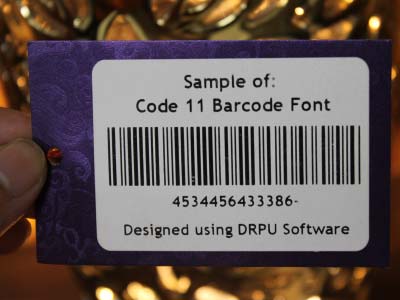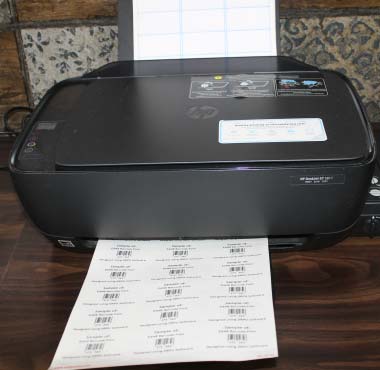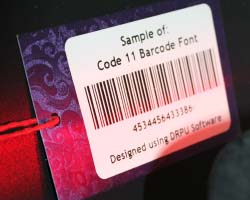Code-11 Barcode: Generate

To generate a Code 11 barcode, you will need a barcode generator software or an online barcode generator tool.
Here are the steps to generate a Code 11 barcode:
-
Choose a Barcode Generator Tool:
There are several free and paid barcode generator tools available online. You can choose any tool that suits your needs.
-
Enter the Barcode Data:
Once you have selected the barcode generator tool, you need to enter the data that you want to encode in the barcode. In the case of Code 11, you can enter any combination of numbers from 0 to 9 and the dash (-) symbol.
-
Choose the Barcode Type:
Select Code 11 as the barcode type from the list of available barcode types.
-
Adjust the Barcode Settings:
You can adjust the size, orientation, and resolution of the barcode as per your requirements.
-
Preview and Download the Barcode:
After adjusting the settings, preview the barcode to ensure that it is readable. If it looks fine, download the barcode in the desired format, such as PNG, JPG, PDF, or SVG.
-
Launch the Barcode Studio Software:
After installing Barcode Studio, launch the software on your computer.
-
Choose the Barcode Type:
Select Code 11 as the barcode type from the list of available barcode types.
-
Enter the Barcode Data:
Enter the data that you want to encode in the barcode. You can enter any combination of numbers from 0 to 9 and the dash (-) symbol.
-
Customize the Barcode:
You can customize the size, orientation, font, colour, and other settings of the barcode as per your requirements.
-
Preview and Print the Barcode:
After adjusting the settings, preview the barcode to ensure that it is readable. If it looks fine, print the barcode on a label or any other printable medium.
Note: Make sure that the printer resolution and label size are appropriate for the barcode size and density. A wrong resolution or size can lead to an unreadable barcode.
Code-11 Barcode: Print
To print a Code 11 barcode, you will need a barcode printer and barcode label software. The software will allow you to create the barcode design and format it to meet your needs. Here are the steps to print a Code 11 barcode:

-
Choose the barcode label software:
There are many barcode label software options available. You should select the software that is compatible with your barcode printer and meets your business requirements. Some popular barcode label software options are Bartender, Zebra Designer, and Nice Label.
-
Create the barcode design:
Once you have chosen the barcode label software, you can create the design for your Code 11 barcode. You will need to specify the type of barcode you want to print, which in this case is Code 11. You can also specify other attributes like the barcode height, width, and text position.
-
Enter the barcode data:
You will need to enter the data that you want to encode in the barcode. Code 11 can encode numeric data, so you can enter the numbers that you want to print as a barcode.
-
Customize the barcode:
You can customize the Code 11 barcode by changing the font type, font size, and colour of the barcode. You can also add text or other graphics to the barcode label.
-
Preview the barcode:
Before printing the barcode, you should preview the label to make sure that it meets your specifications. You can make any necessary adjustments before printing.
-
Print the barcode:
Once you are satisfied with the barcode design, you can print the label. Make sure that the label printer is set up correctly and that the label stock is loaded correctly. Test print the label to ensure that the barcode is printed correctly.
-
Verify the barcode:
Once you have printed the Code 11 barcode label, you should verify that it can be scanned successfully. Use a barcode scanner to scan the barcode and confirm that the correct data is decoded.
Code-11 Barcode: Scan
Code 11 barcodes can be scanned using handheld barcode scanners or stationary barcode scanners. The barcode scanner emits a laser or LED light that reflects off the barcode, and the scanner reads the reflection to decode the information encoded in the barcode.
To scan a Code 11 barcode, follow these steps:

- Prepare the barcode: Ensure that the barcode is clean and unobstructed. If the barcode is dirty or damaged, it may not scan properly. Also, ensure that there is enough space around the barcode to allow the scanner to read it easily.
- Position the scanner: Position the scanner so that it is directly above the barcode and perpendicular to the barcode. If the scanner is at an angle to the barcode, it may not read the barcode properly.
- Activate the scanner: Activate the scanner by pressing the trigger or button on the scanner. Some scanners may automatically activate when they detect a barcode in their field of view.
- Scan the barcode: Aim the scanner at the barcode and hold it steady. The scanner will emit a laser or LED light that reflects off the barcode. The scanner reads the reflection and decodes the information encoded in the barcode.
- Verify the scan: After scanning the barcode, verify that the information displayed on the scanner or computer matches the information encoded in the barcode. If the information does not match, the barcode may not have been scanned properly.
Some barcode scanners may require additional setup or configuration before they can scan Code 11 barcodes. Consult the manufacturer's instructions for specific details on how to set up and use your scanner.
Different types of Devices can read Code-11 Barcode
Code 11 barcodes can be read by a variety of devices, including handheld barcode scanners, stationary barcode scanners, and mobile devices with built-in cameras.
-
Barcode printers:
Barcode printers can also be used to read Code 11 barcodes. These printers are equipped with a built-in scanner that can read and decode barcodes printed on labels or other materials. Barcode printers are often used in conjunction with handheld or stationary barcode scanners to print and scan labels in high-volume applications.
-
Handheld barcode scanners:
Handheld barcode scanners are the most common type of device used to read Code 11 barcodes. These scanners are typically held in the hand and activated by a trigger or button. They emit a laser or LED light that reflects off the barcode, and the scanner reads the reflection to decode the information encoded in the barcode. Handheld barcode scanners are available in both wired and wireless models.
-
Stationary barcode scanners:
Stationary barcode scanners are designed for high-volume, automated scanning applications. These scanners are often integrated into production lines or point-of-sale systems. They use a fixed laser or LED light source and a motorized scanner head to scan the barcode as it passes by on a conveyor belt or other moving surface. Stationary barcode scanners are typically more expensive than handheld scanners, but they are faster and more reliable for high-volume scanning applications.
-
Mobile devices:
Many modern mobile devices, such as smart phones and tablets, have built-in cameras that can be used to scan Code 11 barcodes. To scan a barcode using a mobile device, you need to download a barcode scanning app that can decode the information encoded in the barcode. Barcode scanning apps are available for both Android and iOS devices. Some mobile devices also support near-field communication (NFC) scanning, which allows them to read barcodes by holding the device close to the barcode.
Download and Install CODE-11 Barcode Software
Overall, the type of device used to read Code 11 barcodes will depend on the specific application and scanning requirements. Handheld scanners are ideal for mobile scanning applications, while stationary scanners are better suited for high-volume, automated scanning applications. Mobile devices can be used for on-the-go scanning, and barcode printers can be used to create and scan labels.
Code-11 Barcode is also used at International Level
-
Code 11 barcode is a linear barcode type that is commonly used in the United States and other countries for inventory tracking and other applications. While it is not as widely used as some other barcode types, it is still recognized and accepted by many businesses and organizations around the world.
-
The Code 11 barcode can encode 10 numeric digits (0-9) and 6 special characters (-, ., $, /, +, %). The barcode is made up of alternating bars and spaces, with each character represented by a unique pattern of bars and spaces. The Code 11 barcode also includes a start and stop character, which are used to indicate the beginning and end of the barcode.
-
In order to scan a Code 11 barcode, a barcode scanner is required. Barcode scanners come in a variety of types and styles, including handheld scanners, desktop scanners, and mobile scanners. Some barcode scanners are also equipped with additional features, such as Bluetooth connectivity or the ability to read multiple barcode types.
-
Once a Code 11 barcode has been scanned, the data encoded in the barcode can be decoded and used for a variety of purposes. For example, in inventory tracking applications, the barcode data can be used to update inventory levels and track product movements throughout the supply chain.
-
In terms of international use, the Code 11 barcode is generally accepted and recognized by businesses and organizations around the world. However, some countries may have their own specific barcode standards or regulations, so it is important to check with local authorities or industry associations to ensure compliance with local requirements.
Implementation Cost of Code-11 Barcode:
The cost of implementing Code 11 barcode depends on various factors, such as the number of barcode labels required, the barcode printing technology used, and the software and hardware needed for barcode scanning and data management. In this section, we will discuss the various cost components of implementing Code 11 barcode.
-
Barcode label printing technology:
The first cost component in implementing Code 11 barcode is the barcode label printing technology. There are several types of printing technologies available, such as thermal transfer, direct thermal, and inkjet printing. The choice of printing technology depends on various factors such as the label size, printing volume, and printing quality required. The cost of the printer varies according to the printing technology, with thermal transfer printers being more expensive than direct thermal printers.
-
Barcode label material:
The second cost component is the barcode label material. The cost of the label material depends on various factors such as label size, label material type (paper, synthetic, or polyester), and label adhesive type. The cost of the label material increases with label size and label material type. Synthetic and polyester labels are more expensive than paper labels.
-
Barcode scanner:
The third cost component is the barcode scanner. The cost of the barcode scanner depends on the type of scanner used, such as handheld or fixed-mount scanners. Handheld scanners are less expensive than fixed-mount scanners. Additionally, the cost of the scanner also depends on the scanning technology used, such as laser, CCD, or image-based scanning.
-
Barcode software:
The fourth cost component is the barcode software. Barcode software is used to design and print barcode labels and manage barcode data. The cost of the software depends on the features and functionality required, such as label design, data management, and database connectivity. Additionally, the cost of the software also depends on whether it is a standalone software or an enterprise-level software that can be integrated with other software systems.
-
Data management system:
The fifth cost component is the data management system. Barcode data needs to be managed efficiently, and a data management system is required for this purpose. The cost of the data management system depends on the features and functionality required, such as data storage, retrieval, and reporting. Additionally, the cost of the data management system also depends on whether it is a standalone system or an enterprise-level system that can be integrated with other software systems.
-
Implementation and training:
The final cost component is the implementation and training cost. Implementing a Code 11 barcode system requires setting up the hardware, software, and data management systems, and training the employees to use the system efficiently. The implementation and training cost depends on the complexity of the system and the number of employees who need to be trained.
The cost of implementing Code 11 barcode technology will depend on a number of factors, including the type and number of barcode scanners required, the software and hardware needed to decode and process barcode data, and any additional infrastructure or support needed to integrate barcode technology into existing business processes. However, in general, Code 11 barcode technology is relatively inexpensive and can provide significant benefits in terms of increased efficiency, accuracy, and productivity.
In conclusion, the cost of implementing Code 11 barcode depends on various factors such as the barcode label printing technology used, barcode label material, barcode scanner, barcode software, data management system, and implementation and training cost. The cost of implementing Code 11 barcode can range from a few hundred dollars to several thousand dollars, depending on the scale of the implementation and the complexity of the system.